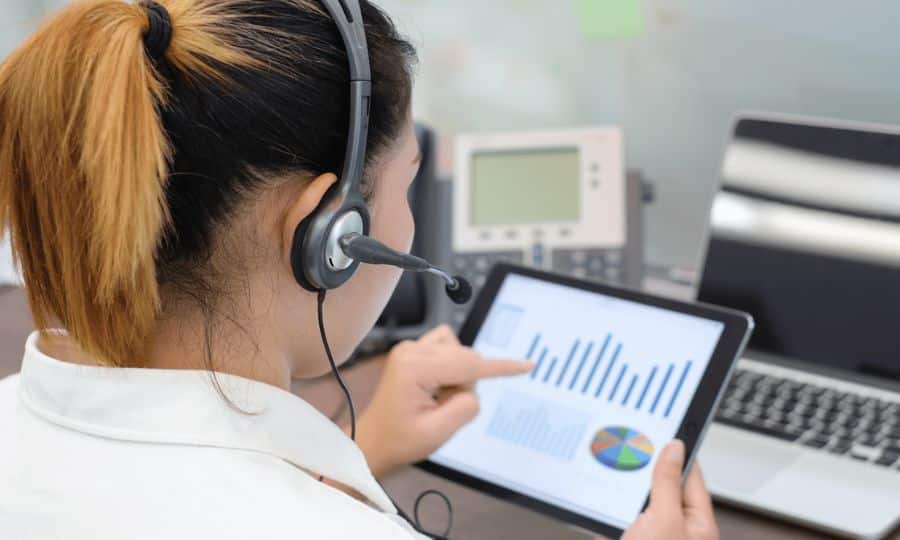What Is Call Tracking & How Does It Work?
Let’s face it: the only way to generate and convert more calls is to track them, as you can only rely on data when making strategic decisions in marketing and sales. Whether you draw calls for your internal sales department or sell calls to advertisers, a robust call tracking system can put you ahead of the competition.
- Based on a unique call tracking number assigned to a specific traffic source, call tracking can dissect the caller’s journey to unlock actionable insights you can use in marketing and sales.
With twice more calls to U.S. businesses from ads than ten years ago, the value of call tracking is absurd for today’s online businesses. Phone calls bear the highest conversion rate, potentially converting every second caller or 15 times more leads than any web interaction.
Read on to learn to leverage call tracking to the fullest.
Table of Contents
What Is Call Tracking?
- Call tracking monitors and evaluates the caller’s journey and the performance of your marketing campaigns and sales reps by connecting the caller to a unique phone number that allows you to identify the campaign, traffic source, ad, and keyword that triggered the call.
A big part of call tracking is collecting customer data at every touchpoint and passing it to the live agent that receives the call. You need to know what ad and keyword triggered the call, how long it lasted, and whether it resulted in a conversion.
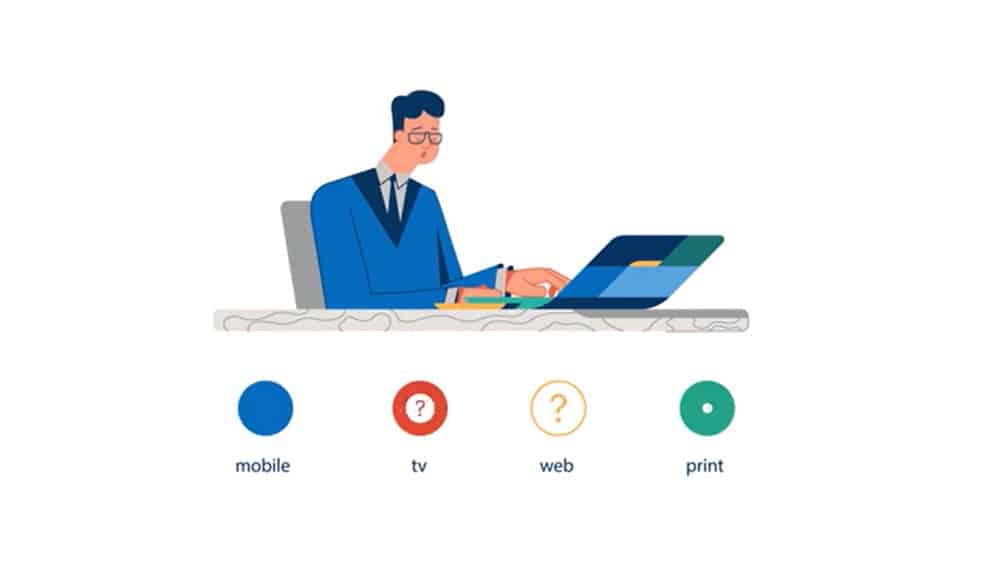
Call tracking software collects:
- Caller data: demographics, psychographics, history of purchases, etc.
- Call data: call timestamp, whether the call converted or bounced, whether the call is from a new or loyal customer.
- Marketing data: the campaign, ad, and keywords that triggered the call.
Likewise, you can use call tracking software to evaluate your live agents’ performance, incentivizing your best sales reps while routing calls more effectively. For example, you can prioritize top-performing agents when distributing calls.
Speaking of call distribution, it’s worth noting that call tracking is often used with interactive voice response (IVR), call recorder, and automatic call distributor to process calls most effectively.
How Does Call Tracking Work?
Step 1: Assign a Unique Call Tracking Phone Number to Each of Your Traffic Sources
As you generate calls through multiple campaigns – web, TV, mobile, print, etc. – you need to differentiate your callers. For example, a call driven by a TV advertisement will likely have a different buyer’s persona and hence require a different sales technique than a call from a loyal customer.
- Call tracking numbers – local, international, and vanity – make it possible to precisely track the traffic source and ad that triggered the call while unlocking marketing insights and transferring them in real-time to your live agents.
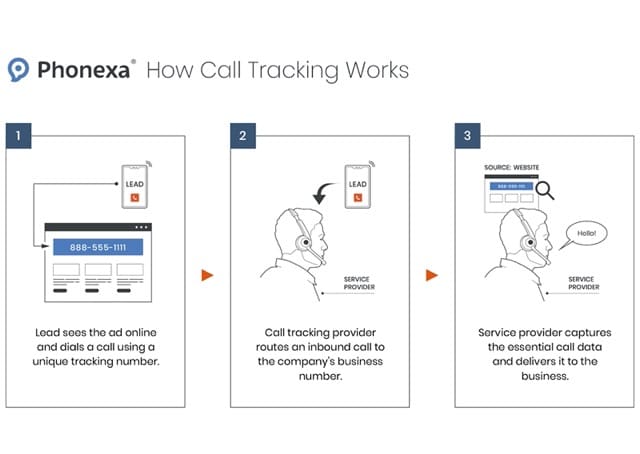
Without a doubt, strategically integrated call tracking numbers can help you better understand customer behavior to optimize your marketing efforts.
Call Tracking Phone Numbers: Local, International & Vanity
| Local | As 75% of customers are most interested in the country of origin of the brand they’re considering, local phone numbers benefit local businesses and businesses focused on specific audiences. With local call tracking numbers, you can target certain demographics in specific regions and track the success of local marketing campaigns.Local numbers are cost-efficient and may help you save on long-distance, international, or roaming fees, not to mention they can create a sense of loyalty and trust with your customers. |
| International | International call tracking numbers are a must for global businesses, as they allow you to track calls from all countries while making calls toll-free for callers. Even the most high-intent callers are unwilling to pay for the call regardless of the value they expect to get in return. |
| Vanity | Vanity phone numbers are tailor-made trackable phone numbers – for example, 844-PHONEXA – used to imprint your brand’s name into the caller’s mind. Some vanity numbers – 1-800-FLOWERS or 1-800-GO-FEDEX – have achieved international success, generating billions of dollars for their companies. |
Toll-free international and vanity numbers are superb for increasing your reach and tracking the success of your multi-location marketing efforts, whether paid search campaigns on Google Ads, landing pages, or offline marketing campaigns such as billboards, TV, and radio ads.
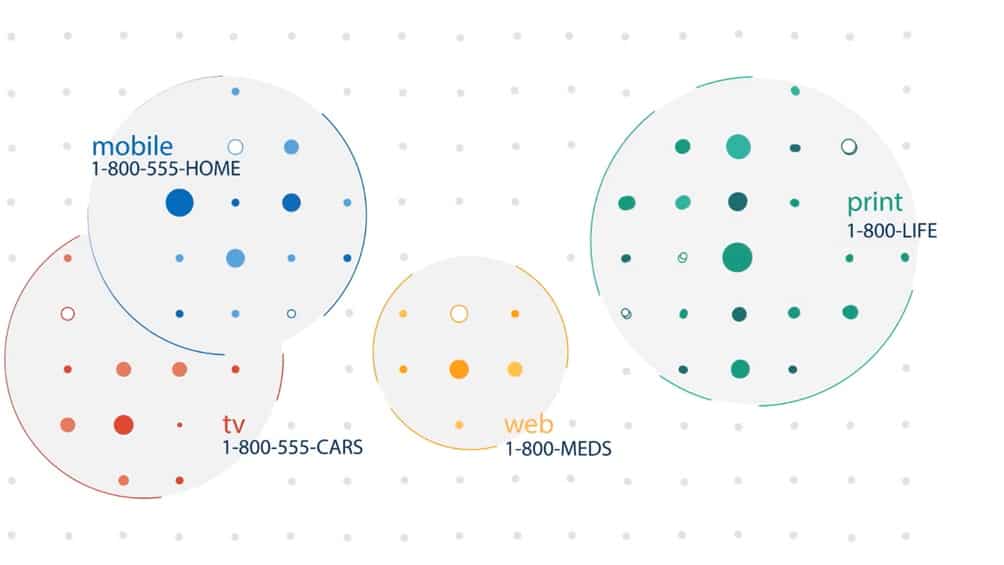
Static vs. Dynamic Call Tracking Numbers
The choice of your call tracking numbers comprises several dimensions, one of which is whether to choose static or dynamic numbers.
Between static and dynamic call tracking phone numbers, choose the following:
- For traditional marketing campaigns (flyers, billboards, TV ads, etc.), use static phone tracking numbers.
- For digital marketing campaigns (any ads displayed online), use dynamic phone tracking numbers.
The difference between static and dynamic call tracking numbers is that static numbers remain the same for every caller from a particular traffic source, whereas dynamic numbers change depending on how the call was triggered. In other words, website visitors brought by different marketing campaigns will see two different dynamic numbers on the same webpage while still speaking to the same sales department after dialing those different numbers. This feature of dynamic call tracking numbers is called dynamic number insertion (DNI).
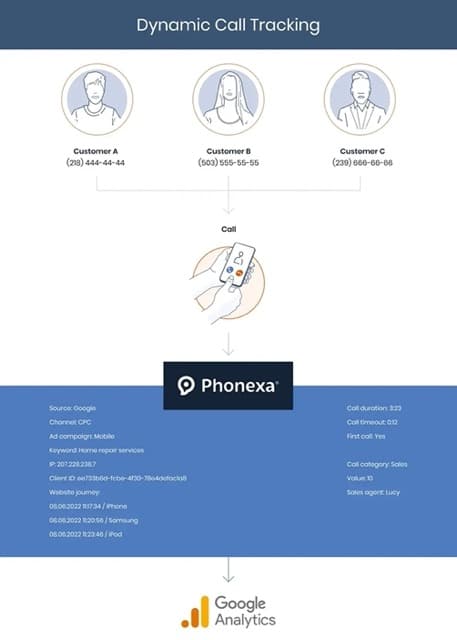
Source: Phonexa
The most important thing when implementing dynamic call tracking numbers is to accurately determine how many numbers you need to cover the needs of your business while not overpaying for the numbers you will unlikely use.
- The rule of thumb is that you need around 1% of your website’s daily visits. For 1,000 daily visits, you need 10 dynamic numbers; for 5,000 daily visits, you need 50 numbers, and so on.
Dynamic call tracking gives you real-time insight into which campaigns are bringing in the most leads, and which ones are lagging behind and may be eliminated. With such valuable data, you can make risk-free strategic decisions easier.
Step 2: The Caller Dials Your Phone Number and (Optionally) is Greeted by Your IVR
The call tracking process continues as your caller dials your phone number and interacts with your interactive voice response (IVR), a must for businesses willing to expedite the customer journey.
Via touch-tone keypad or voice responses, your IVR interacts with the caller while collecting their data to qualify them to the most relevant sales agent or even solve the request on the spot. When paired with an automatic call distributor (ACD), IVR sends the caller on the conversion path while eliminating the need to wait in a call queue, a nuisance repelling up to 40% of callers.
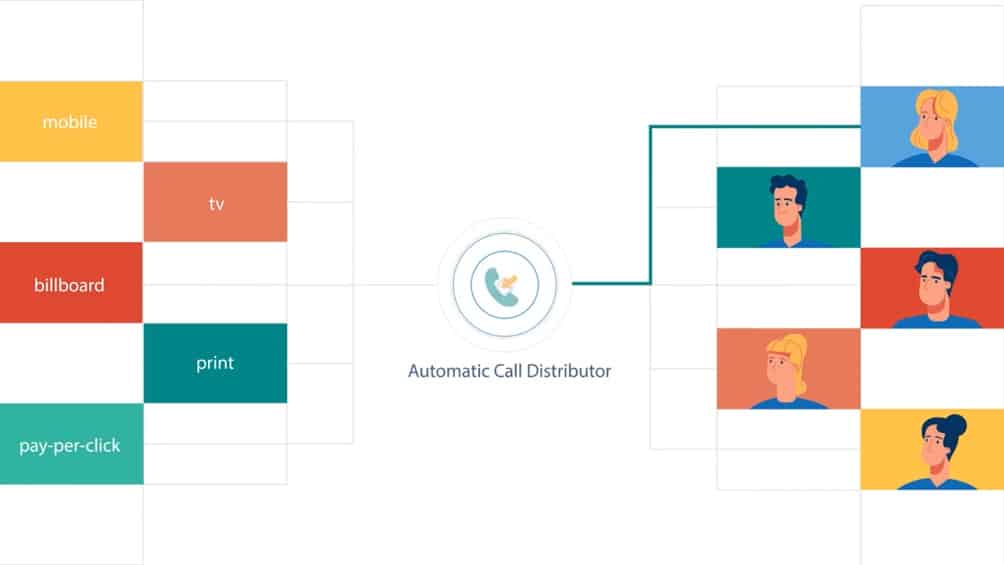
A cloud-based IVR system allows you to direct branded greetings to your callers while improving the efficiency of your sales reps.
Call Distribution Criteria
Call distribution criteria are rules to distribute calls among live agents. You can consider any factors, including the type of the call (sales, customer service, etc.), the caller’s language, the agent’s availability and performance, and more.
Popular Call Distribution Criteria
| Availability | Distributing calls to available live agents means not losing callers in a call queue while hampering the productivity of the call, as some calls require special expertise from live agents. |
| Performance | Distributing high-intent callers to top-performing agents increases the conversion rate at the cost of leaving aspiring sales reps with fewer calls. |
| Location | Location-based distribution ensures the caller and the agent are on the same page, with the latter being informed about the geographical or cultural peculiarities that may relate to the subject of the call. For example, flood insurance seekers from California will likely get the best experience communicating with an agent from California, as the latter will likely know all the ins and outs of the deal. |
| Language | Language-based distribution makes sense for global businesses because not all customers speak English fluently, wanting to use their first language for better understanding. With sales reps in different parts of the world, it’s only natural to route inbound calls based on the caller’s language. |
| Cherry Pick | Being able to take any call from the call pool, agents can constantly receive calls at the cost of the quality of customer service. The cherry-pick distribution may only be viable when your sales reps work as a team. |
| Company Size | If you sell call leads to different companies, you can choose the priority seller as the biggest or the highest-paying company or bidder. |
The most successful lead distribution model is usually a mixed one, when several criteria are applied to reflect your audience, technical capabilities, and business needs.
Step 3: The Caller Connects to a Sales Rep
The grand finale of the customer journey is conversion, which is more likely to happen when the sales agent has the required expertise and – no less important – detailed customer data collected throughout the caller’s journey.
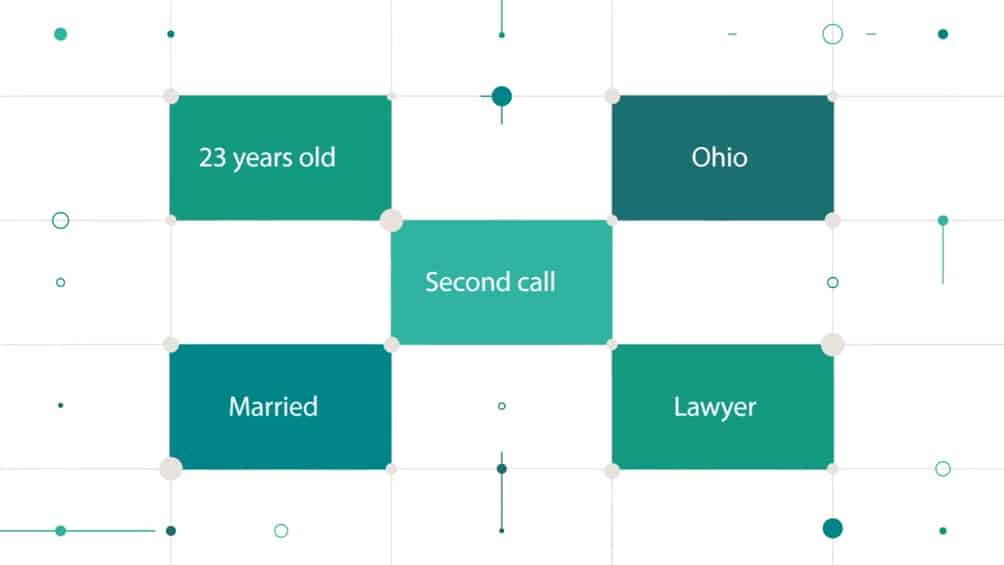
How Big of a Difference Does Call Tracking Make?
Businesses are going the extra mile to make consumers accept newer technologies like AI and chatbots, but calls remain critical to the customer journey. In fact, only 13% of customers would use chatbots, with the rest relying on good-old phone calls to contact a business.
A well-designed call tracking system can:
- Improve the customer journey. With around 60% of customers craving tailored engagement, you can’t generalize inbound calls. Combining call tracking and distribution features with call analytics will help you customize calls for every customer.
- Enable data-driven customer distribution. The least you want is to connect customers to the wrong agent or distribute them randomly. Call tracking will allow you to route inbound calls based on call analytics and customer data.
- Improve sales agents’ performance. Informing the sales agent about the caller before the call will increase the conversion rate dramatically, as your agents will tailor their approach to every caller. Likewise, your sales agent won’t receive irrelevant calls and calls they cannot process effectively.
- Improve budget allocation. Not all marketing campaigns are equal. Call tracking will allow you to identify your most and least effective marketing campaigns, traffic sources, ads, and keywords to allocate your budget and efforts accordingly.
- Automate and scale inbound calls. Not only is manual call processing impossible for large businesses, but it’s nowhere near as efficient as a well-designed automatic call routing system that takes and distributes calls instantly while completing smaller requests on the spot, independently of live agents.
Call tracking has become invaluable for businesses of all sizes in today’s rapidly changing market, allowing you to tap into untapped markets with much less risk. After all, nothing can give you caller insights as deep as well-configured call tracking software, regardless of what and to whom you sell.

